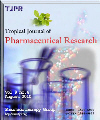
|
Tropical Journal of Pharmaceutical Research
Pharmacotherapy Group, Faculty of Pharmacy, University of Benin, Benin City, Nigeria
ISSN: 1596-5996
EISSN: 1596-5996
Vol. 8, No. 1, 2009, pp. 87-94
|
 Bioline Code: pr09012
Bioline Code: pr09012
Full paper language: English
Document type: Research Article
Document available free of charge
|
|
|
Tropical Journal of Pharmaceutical Research, Vol. 8, No. 1, 2009, pp. 87-94
| en |
Spectroscopic Studies of the Electron Donor-Acceptor Interaction of Chloroquine Phosphate with Chloranilic Acid
Ofokansi, KC; Omeje, EO & Emeneka, CO
Abstract
Purpose:
The electron donor-acceptor interaction between drugs which act as electron donors and some electron-deficient compounds (π acceptors) has severally been utilized as an analytical tool for the quantitation and qualitative assessment of such drugs. The objective of this study, therefore, was to develop an assay procedure for dosage forms of chloroquine phosphate based on its reaction with chloranilic acid which resulted in the formation of a charge-transfer complex.
Methods:
The complex formation between chloroquine phosphate and chloranilc acid as evidenced by the instantaneous change in colour of a solution of chloranilic acid in dioxan from yellow to purple upon addition of a solution of chloroquine phosphate in chloroform was monitored spectrophotometrically to determine the wavelength of maximum absorption. The stoichiometry of the complex formed was evaluated using the Job’s continuous variation method while the thermodynamics of the complex was evaluated spectrophotometrically with the aid of the Benesi-Hildebrand plot.
Results:
Spectrophotometric absorption studies showed evidence of the formation of strongly bonded and highly stable charge-transfer complex between chloroquine phosphate and chloranilic acid in a 3:2 stoichiometry in non-aqueous medium. The transitions involved were detected at wavelengths longer than those of the individual pure substances in the visible region of the spectrum. Conformity with Beer’s law was evident over the concentration range 0.8 – 8.0 mg/100 ml of chloroquine phosphate; thus making it possible for an accurate quantitative determination of the drug.
Conclusion:
The studied complexation phenomenon formed a basis for the quantitative determination of both pure samples and individual dose units of chloroquine phosphate and is considered a simple, sensitive and precise analytical tool with high accuracy for routine analysis of chloroquine phosphate in developing countries where sophisticated analytical instruments may not be available.
Keywords
Spectroscopic studies, Electron Donor-Acceptor Interaction, Chloroquine phosphate, Chloranilic acid.
|
| |
© Copyright 2009 - TJPR Faculty of Pharmacy, University of Benin, Benin City, Nigeria
Alternative site location: http://www.tjpr.org
|
|
